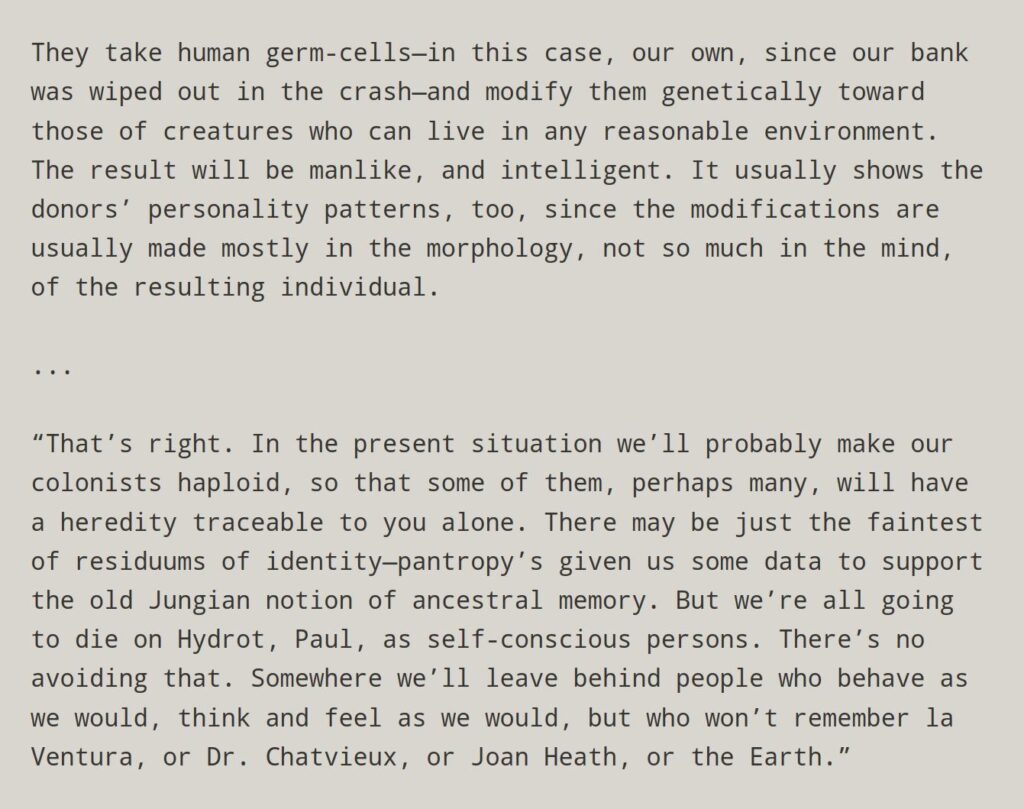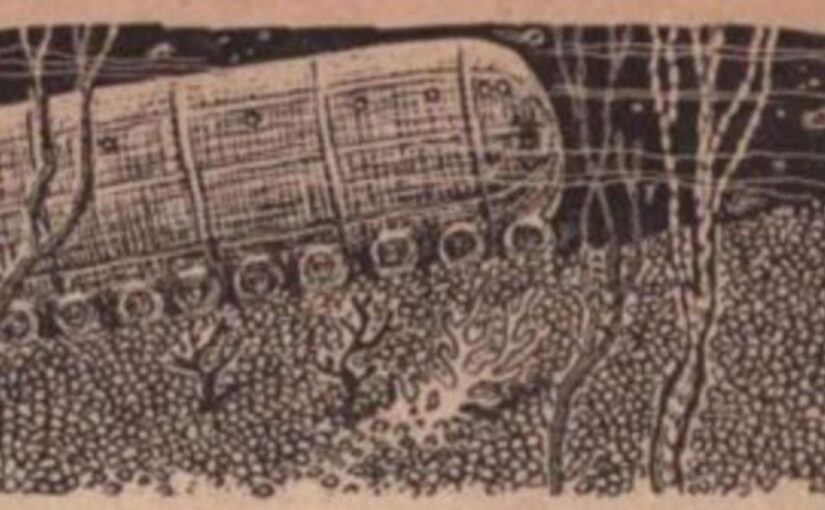This post is a free (short) science fiction story called “Surface Tension”. It’s a classic story, and well worth the read.
A contributor wrote a story (or two) Heh Heh… and it was good, I’ll tell you what. But I will not publish it here. What I will say is that it reminded me of another story. Not that I know why… the two stories are completely different in every way. But it did jar my memories, and so I unearthed this gem.
It’s a story I read when I was 12 years old or so, and man oh man, did it awaken my soul and stir up some stuff inside.
It’s funny that way. How unrelated things can come together and create thought movements.
Such as this post…
“Surface Tension” by James Blish first appeared in the August 1952 issue of Galaxy Science Fiction. In 1957 it was published by Gnome Press as The Seedling Stars along with three other pantropy stories by Blish to make a fix-up novel.
When the Nebula Awards were being created in the 1960s, the Science Fiction Writers of America voted for their favorite science fiction short stories published before the advent of the awards and “Surface Tension” was included in The Science Fiction Hall of Fame Volume One in 1970.
It has been anthologized many times.
The version of “Surface Tension” in The Big Book of Science Fiction is different from the one that appeared in The Science Fiction Hall of Fame.
It has “Sunken Universe” (Super Science Stories, May 1942) inserted into it after the introduction, which is the way it is in The Seedling Stars. However, the introduction had additional paragraphs not in the Hall of Fame version, and I expect a careful reading of the later sections should show changes too. H. L. Gold was known for editing stories and Blish was known for rewriting his stories, so we don’t know which happened.
My guess is Blish came up with additional ideas to add to the story for the book version. I’ve read the slightly shorter version three times before over my lifetime, and a few paragraphs in this version stood out to me as new. Mainly they were about the original crew theorizing about their future pantropic existence.
Lately I’ve been writing about why I disliked a story, but for “Surface Tension” I need to explain why I love a story, and that might be even harder to do.
Every once in a while, a science fiction writer will come up with an idea that’s so different that it lights up our brains.
- Wells did it with “The Time Machine.”
- Heinlein did it with his story “Universe.”
- Brian Aldiss did it with his fix-up novel Hothouse.
- Robert Charles Wilson did it with his novel Spin.
“Surface Tension” is one of those stories. It has tremendous sense of wonder.
I’m torn between explaining everything that happens and not saying anything. But I need to talk about “Surface Tension,” so if you haven’t read it, please go away and do so.
As I’ve said before about great short stories, they have a setup that allows the author to say something interesting – not a message, but an insight.
The setup for “Surface Tension” is five men and two women have crashed on the planet Hydrot that orbits Tau Ceti. Their spaceship can’t be repaired, their communication system was destroyed, and they don’t have enough food to survive.
However, their ship is one of a swarm of seed ships spreading across the galaxy that colonizes each planet with customized humans adapted for each unique environment.
This is called pantropy, also representing a kind of panspermia, and anticipates the idea of transhumanism.
In other words, Blish has a lot to say with this story.
Because no large organisms can survive in the current stage of Hydrot’s development, the crew decide to seed it with intelligent microorganisms.
The seven will die, but each of their genes will be used to fashion a new species of roughly humanoid shape creatures that can coexist with the existing microorganisms of the freshwater puddles on Hydrot.
They won’t have their memories, but they will have ancestral abilities.
The crew creates these creatures and inscribe their history on tiny metal tablets they hope will be discovered one day by their tiny replacements.
From here the story jumps to the underwater world of the microorganisms and we see several periods of their history unfold. Blish used his education in biology to recreate several concentric analogies of discoveries that parallel our history in his puddle world of tiny microorganisms.
The wee humanoids form alliances with other intelligent microorganisms in wars to conquer their new environment.
Then they begin an age of exploration that eventually parallels our era of early space exploration. But you can also think of it paralleling when life first emerged from the sea to conquer the land.
One reason this story means so much to me is Blish makes characters out of various types of eukaryotic microorganisms and that reminds me of when I was in the fourth grade and our teacher asked us to bring a bottle of lake water to class.
That day we saw another world through the eyepiece of a microscope.
Blish made that world on a microscope slide into a fantasy world where paramecium becomes a character named Para who is intelligent and part of a hive mind that works with the transhumans.
Their enemies are various kinds of rotifers. However, I know little of biology and don’t know what the Proto, Dicran, Noc, Didin, Flosc characters are based on.
The main transhuman characters are Lavon and Shar who’s personalities are preserved over generations.
I wondered if the seven original human explorers (Dr. Chatvieux, Paul la Ventura, Philip Strasvogel, Saltonstall, Eleftherios Venezuelos, Eunice Wagner, and Joan Heath) were archetypes for the microscopic transhuman characters? Blish suggests that in the opening scene:

However, I never could decipher who Lavon and Shar were. Each time I reread this story I notice more details, and more analogies. “Surface Tension” is both simple and complex.
At a simple level its just a space adventure tale about exploration and survival.
But in creating a fantasy ecology, Blish hints at the deeper complexity of a writer becoming a worldbuilder.
And Blish is also philosophical about the future of mankind, reminding me of Olaf Stapledon.
This is the kind of story that can blow adolescent minds. Like mine.
The entire story is HERE in PDF form. Enjoy the free download and the great story!
-MM


